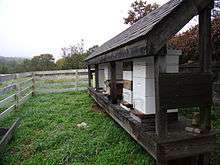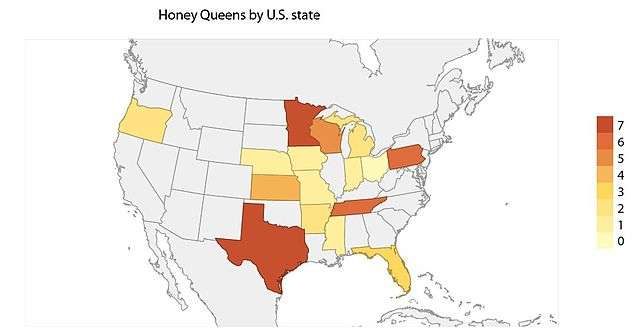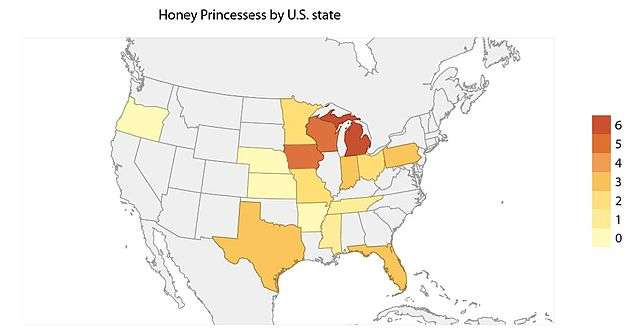Honey Queen Program
The American Honey Queen Program is a local, state, and national program which annually selects young women to become the spokespeople for the beekeeping industry in the United States. This program is facilitated through the American Beekeeping Federation and involves a competition, the winner of which travels around the United States promoting the beekeeping industry and educating the public about bees and honey.
History and Origins

When establishing the Honey Queen Program, the founder, Esther Piechowski, tapped into already established markets such as the American Association of Advertising Agencies and Teacher's Homemakers of America. In Redgranite, Wisconsin, she developed the Honey Queen Program on the state level, crowning the first Wisconsin Honey Queen in 1957. In 1959, the first American Honey Queen was chosen and given a banner, to identify her title, and a crown. Piechowski next expanded the program to the national level by highlighting its potential: its relatively low cost, the opportunities to raise awareness, and marketing opportunities. Her platform was accepted and developed into a committee. The program started at a grassroots level and has since evolved to include 18 states that have either a Honey Queen or Honey Princess (see Participating States.) Over time, the number of states participating has fluctuated for myriad reasons. As the number of beekeepers and the strength of the organization within a given state decline, fewer Honey Queens came out of that particular state. Due to the professionalism embedded within each Honey Queen, there will always be a role for her as a spokesperson, and the program remains valuable.
Historically, a greater proportion of Southern states sent participants to the competition due to the established culture of Beauty Queens.[1] The founders of the program thought that a young, attractive woman would be able to easily get interviews with radio and eventually television and easily engage with the general public. However, the emphasis of the criteria to select a Honey Queen has shifted in recent decades from physical appearance to communication and professionalism.
Purpose
The American Honey Queen Program is a national competition program sponsored by the American Beekeeping Federation (ABF), with its main priorities being the promotion of the world of beekeeping, to increase the national honey consumption, and educate the public about the value of honey bees.[2] The American Beekeeping Federation is a national organization that supports the interests of all beekeepers and individuals associated with the beekeeping industry in the United States.[3] A queen and princess are crowned each year, serving as representatives and salespersons of the entire beekeeping industry in the U.S. The Honey Queen and Princess aim to educate the public spreading their experience and knowledge of the beekeeping and honey industry, focusing on issues such as how the U.S. agriculture depends on a healthy honey bee population as far as the pollination of the nation’s crops. The Honey Queen and Princess also raise public awareness of the benefits of honey —how honey is a healthy substitute for sugar, how it extends the shelf life of baked products, and haw it adds a unique quality such as flavor or texture to other products.[4]
Competition
The American Honey Queen Program is a competitive local, state and national program. A queen is selected at the national level and the runner-up becomes the Honey Princess. The Honey Queen Committee, which is considered the “backbone” of the Honey Queen Program consists, at all three levels, of a chairperson and two or more members of the association. The selection of the American Honey Queen begins at the local level; candidates must apply and be selected by the members of the Local Honey Queen Program.[5] “Selection of the Local Honey Queen may either be through a contest sponsored by an association or individual or by simply selecting a young lady who has the qualities to fulfill the position of Local Honey Queen”.[6] Local Honey Queen candidates are young women from an accredited high school or college who are approved by the Honey Queen Committee.[7] There are few competition requirements for the Local Honey Queen and selection is often based most upon her interest in the program and her willingness to learn about honey, bees and beekeeping.[8]
Knowledge a Local Honey Queen should acquire and demonstrate:[9]
- About beekeeping
- Parts of the hive and their proper names
- Three castes of bees – Queen, Drone, Worker – and their responsibilities
- Floral sources of the area represented
- Production of honey
- Processing of honey
- Seasonal management of colonies
- Benefits of the honeybee to agriculture and natural resources through pollination
- About honey
- Normal range of area honey’s moisture content
- Granulation – what causes it and what to do about it
- Conversion of recipes from sugar to honey
- Varieties of honey
- Cooking hints
- Other uses of honey
- About other marketable products of the hive
- Pollen
- Royal Jelly
- Beeswax
- Propolis
- Pollination service
- Bee venom
Once a Local Honey Queen is selected, she may move on to compete at the state level. For states that do not have a Local Honey Queen Program, there may be a selection at the state level as well, based on the candidate’s professionalism, interest in public speaking and communication, interpersonal skills, willingness to learn about beekeeping and honey, essays and interview process, and she should possess the same knowledge about bees and beekeeping that candidates at the local level are required to have. State Honey Queen candidates must be between 17 and 24 years old. State Honey Queens also compile a scrapbook of all of their accomplishments, travels, and things she did as a Honey Queen- how she promoted the industry over time, all the schools, agricultural events, festivals she participated in; TV and radio interviews, newspaper articles, cooking demonstrations, State and County Fair participation- to be presented and evaluated at the national competition.[10]
The third tier of competition is the national level, the American Honey Queen Contest. The state and national level competitions are very similar in terms of what the candidates are judged on. Candidates must be between 18 and 25 years of age at this level, and are required to have served as local or state honey queen for at least six months prior to the competition. Each American Honey Queen candidate must submit an application, list of her state promotions, an essay on an aspect of beekeeping or honey production, a brief autobiography and three photographs in order to compete. As part of the competition, she is required to give a marketing or sales presentation on a topic selected by the American Honey Queen Committee directed to an audience of her choice (i.e. adult, youth), portions of which she will likely adapt and incorporate into her presentations during her travels around the country as Honey Queen. Additionally, she presents the scrapbook of her travels and work as a state Honey Queen; the judges evaluate the scrapbook to assess how active the state Honey Queen was during her reign, making sure that she traveled to a variety of places.[11] The national competition is held at the American Beekeeping Federation’s national annual convention in January.[12]
The American Honey Queen is selected by a panel of three judges. The judges are appointed by the chair who looks for attendees of the ABF convention that have extensive knowledge in the beekeeping industry, experience with the competition, and/or public relations.[13] The chair tries to include both someone from within the industry who has a firm base of knowledge and possibly someone from outside the organization with a media background, such as a reporter. The judges change every year and maintain an undisclosed identity throughout the convention so that they can observe candidates in multiple facets.
More details on the competition, judging, and eligibility criteria such as marital status, appropriate attire, concealment and removal of body art and piercings, etc. can be found in the American Beekeeping Federation’s “American Honey Queen Program Guidelines for Honey Queen Programs.”
Responsibilities and Activities
Honey Queens are spokespeople for the honey and beekeeping industries in America. The Honey Queen program actually plays a significant role in the beekeeping community as it provides a considerable amount of publicity for the beekeeping community, furthering the nation’s understanding of how honey bees act as major crop pollinators and how crucial they are to the nation’s agriculture as well as giving lessons in baking with honey and general beekeeping tips.They travel across their area of representation (community, state, or country), visiting schools, state and county fairs, conventions, farmers markets, and various club meetings.[14] The intentions of their travels and activities are to increase consumption of honey and other bee products/services as well as make citizens more aware of honey and the issues surrounding it.[15] While there, they sometimes conduct demonstrations such as cooking with honey or basic beekeeping. On other occasions, they give presentations and answer the public’s questions, while also tactfully correcting misinformation. They even publish brochures which can be made available to the public through whoever is facilitating the Honey Queen’s visit. Furthermore, The public is encouraged to contact and invite the Honey Queen to give presentations at events. As spokespeople for the industry, Honey Queens give interviews through a variety of media sources such as radio, newspaper, television, and most recently the internet. The current American Honey Queen and Princess maintain a website designed for children, Buzzing Across America, providing easy to understand information about honey, bees, and beekeeping. They also maintain a Facebook page. On these two websites, they blog about their activities during their reign and advertise upcoming events. Both of these online outlets allow members of the public to ask the Honey Queen and Princess questions. Honey Queens are able to travel across the country on the budget of the American Beekeeping Federation. They stay with host families (usually beekeepers) which facilitate their movements to and from promotional and educational activities.
Participating States
American Honey Queens and Honey Princesses have hailed from the following states: Michigan, Tennessee, Washington, Idaho Oregon, North Dakota, South Dakota, Nebraska, Ohio, Arkansas, Mississippi, Florida, Indiana, Iowa, Kansas, Minnesota, Missouri, New Jersey, Pennsylvania, Texas, and Wisconsin.


| State | Queens | Princesses |
|---|---|---|
| Arkansas | 2 | 0 |
| Florida | 3 | 3 |
| Indiana | 1 | 3 |
| Iowa | 1 | 5 |
| Kansas | 4 | 0 |
| Michigan | 2 | 6 |
| Minnesota | 7 | 2 |
| Mississippi | 1 | 1 |
| Missouri | 1 | 2 |
| Nebraska | 1 | 0 |
| New Jersey | 0 | 0 |
| North Dakota | 3 | 3 |
| Ohio | 0 | 2 |
| Oregon | 2 | 0 |
| Pennsylvania | 6 | 3 |
| South Dakota | 2 | 3 |
| Tennessee | 6 | 1 |
| Texas | 7 | 3 |
| Wisconsin | 5 | 5 |
Current Honey Queen and Princess
The 2013 American Honey Queen is Caroline Adams, from Texas. Caroline Adams is the daughter of Ned and Caryl Adams of Plano, Texas. She began beekeeping six years ago through the Collin County Hobby Beekeepers Association and currently maintains three beehives. Caroline is a student at Collin College in Plano, Texas, where she is majoring in American sign language. In her spare time, Caroline enjoys playing and teaching violin and mandolin, serving at her church, sewing, cooking and, most of all, spending time with her family.
The 2013 American Honey Princess is Emily Campbell, from Minnesota. Emily Campbell is the daughter of Becky Zenke and Erich Campbell. She is originally from Aitkin, Minnesota, and is a junior at the University of Minnesota-Crookston, where she is pursuing a degree in large animal veterinary medicine. She is also a first-generation beekeeper, keeping bees as a hobby. In her free time, Emily enjoys ice fishing, traveling, showing horses and baking. Click here to see a list of past Honey Queens and Princesses.
References
- ↑ Interview with Honey Queen Mary Kettlewell, September 26, 2012
- ↑ Nordhaus, Hannah (2010). The Beekeeper's Lament. Harper Perennial. ISBN 978-0061873256.
- ↑ The American Beekeeping Federation
- ↑ American Honey Queen Program
- ↑ Gillesple, J. "Honey Queen". Collin County Hobby Beekeepers Association. 2009. Web. 16 September 2012
- ↑ “Guidelines for Honey Queen Programs, Rev. 2012,” American Beekeeping Federation (accessed September 16, 2012)
- ↑ Gillesple, J. "Honey Queen" Collin County Hobby Beekeepers Association
- ↑ 1970 Honey Queen from Wisconsin, Nodji VanWychen. Telephone Interview. September 26, 2012
- ↑ “Guidelines for Honey Queen Programs, Rev. 2012,” American Beekeeping Federation: (accessed September 16, 2012).
- ↑ Kari Boyce. Interview. 25 September 2012
- ↑ Interview with Honey Queen Kari Boyce, 25 September 2012
- ↑ Interview with Honey Queen Charlotte Randall, September 24, 2012
- ↑ Interview with Honey Queen Joanne King, September 22, 2012
- ↑ UC Davis, Department of Entomology/Laidlaw Facility: News. UC Davis: University of California.
- ↑ “Honey Queen Program,” Pennsylvania State Beekeepers Association
External links
- "American Beekeeping: Facts About Bees and beekeeping." All About Bees. http://www.facts-about-bees.ml
- Alyssa, Fine, and Dale Danielle. "Buzzing Across America." Buzzing Across America. http://www.buzzingacrossamerica.com/ (accessed September 16, 2012).
- "American Beekeeping Federation: American Honey Queen Program." American Beekeeping Federation. http://abfnet.org/displaycommon.cfm?an=1&subarticlenbr=10 (accessed September 16, 2012).
- "American Beekeeping Federation: Honey Bee Facts." American Beekeeping Federation. http://abfnet.org/displaycommon.cfm?an=1&subarticlenbr=71 (accessed September 16, 2012).
- "Interview with ABF 2012 American Honey Queen Alyssa Fine" YouTube. https://www.youtube.com/watch?v=qxuha1Opv5A (accessed September 16, 2012).
- “American Honey Queen Program.” 2013 North American Beekeeping Conference webpage. http://www.nabeekeepingconference.com/honey_queen.html
- Official Facebook page: http://www.facebook.com/pages/American-Beekeeping-Federation/187316191311832?sk=info
- ABF “Friends of the Bee Fund” http://www.abfnet.org/displaycommon.cfm?an=1&subarticlenbr=133
- “Guidelines for Honey Queen Programs, Rev. 2012,” American Beekeeping Federation. http://www.abfnet.org/associations/10537/files/ABF_QueenProgram_Guidelines_2012.pdf.
- 1970 Honey Queen from Wisconsin, Nodji VanWychen. Telephone Interview. September 26, 2012. http://pages.vassar.edu/honeyqueens/honey-queens/nodji-vanwychen/
- 1974 Honey Queen from Nebraska. Telephone interview. September 25, 2012. http://pages.vassar.edu/honeyqueens/2012/11/15/interview-with-the-1974-american-honey-queen/
- 1978 Honey Princess from Michigan, Lynn Hoopingarner. Telephone Interview. September 20, 2012.http://pages.vassar.edu/honeyqueens/honey-princesses/lynn-hoopingarner/
- 2007 Honey Queen from Minnesota, Kelly Klick. Telephone Interview. October 2, 2012.http://pages.vassar.edu/honeyqueens/honey-queens/kelly-klick/
- 2004 Honey Queen from Pennsylvania, Kristen Lang, Telephone Interview. September 25, 2012.http://pages.vassar.edu/honeyqueens/honey-queens/kristen-lang/